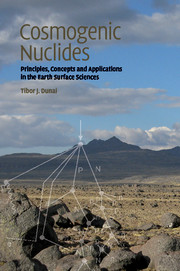Book contents
- Frontmatter
- Contents
- Preface
- 1 Cosmic rays
- 2 Cosmogenic nuclides
- 3 Production rates and scaling factors
- 4 Application of cosmogenic nuclides to Earth surface sciences
- Appendix A Sampling checklist
- Appendix B Reporting of cosmogenic-nuclide data for exposure age and erosion rate determinations
- References
- Index
3 - Production rates and scaling factors
Published online by Cambridge University Press: 29 December 2010
- Frontmatter
- Contents
- Preface
- 1 Cosmic rays
- 2 Cosmogenic nuclides
- 3 Production rates and scaling factors
- 4 Application of cosmogenic nuclides to Earth surface sciences
- Appendix A Sampling checklist
- Appendix B Reporting of cosmogenic-nuclide data for exposure age and erosion rate determinations
- References
- Index
Summary
The accurate knowledge of production rates of cosmogenic nuclides, and how they change as a function of latitude and altitude, is arguably the most important requirement for their successful application to Earth surface sciences. Exposure ages or erosion rates calculated from cosmogenic nuclide concentrations (Chapter 4) can only be as accurate as the production rates and scaling factors they rely on. The aim of this chapter is therefore to provide some background to understand underlying methods and to illuminate key aspects of the ongoing scientific discussion on scaling factors.
Deriving production rates
Production rates can be derived via three different methods from: (i) physical principles, (ii) irradiation experiments and (iii) geological calibration.
From physical principles
Using cosmic-ray flux and nuclear reaction cross-section data the cosmic ray cascade in the atmosphere and its interaction with materials on the Earth's surface can, in principle, be modelled by numerical simulations (Masarik and Reedy1994, 1995, 1996, Masarik and Beer 1999). In practice, the accuracy of this approach is hampered by the limited knowledge of the nuclear reaction cross-sections involved, particularly for neutron-induced reactions (Masarik and Reedy 1995). For proton-induced reactions, a considerable body of data is available (Masarik and Reedy 1995, Michel et al. 1996, Leya et al. 1998); for neutrons, it is usually assumed that neutron-induced reactions have cross-sections similar to those of proton-induced reactions (Masarik and Reedy 1995). However, these approximations have uncertainties of the order of 25% (Masarik and Beer 1999, Leya et al. 2000, Sisterson 2005).
- Type
- Chapter
- Information
- Cosmogenic NuclidesPrinciples, Concepts and Applications in the Earth Surface Sciences, pp. 60 - 76Publisher: Cambridge University PressPrint publication year: 2010



